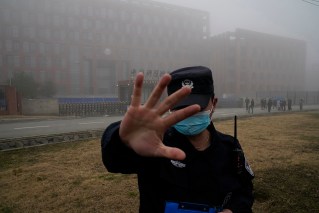Holy cow: Will lab-grown meat save the world or wreck it?

Ten years ago, Dutch pharmacologist Mark Post cooked the world’s most expensive hamburger – €250,000 (about $405,000) – and showed it off to the international media.
It took Dr Post about three months to make the burger patty from muscle stem cells grown in a lab at Maastricht University.
The media launch, however, occurred in London.
A couple of foodies took a bite and gave the burger a thumbs-up for “mouth feel” and for its convincing bite. But it was marked down for a lack of juiciness and flavour.
To be fair, the patty was unseasoned: no tomato sauce, no salt and pepper.
And let’s not forget, no animal was hurt in the making of this burger.
The build-up
Leading up to the burger’s star turn, there was growing media interest in lab-grown as an answer to the food crisis. And the problems posed by climate change.
The cooking and tasting of a cultured meat patty shifted the conversation from possibilities and projections to something more tangible and exciting.
Even so, that excitement and hope had been well primed by widely reported research from the University of Oxford.
The Oxford University figures
In 2011, Oxford researchers published a paper, ‘Environmental impacts of cultured meat production’, in the journal Environmental Science & Technology.
Their analysis estimated that “cultured meat would require 7-to-45 per cent less energy to produce than the same volume of pork, sheep or beef”.
It would require more energy to produce than poultry “but only a fraction of the land area and water needed to rear chickens”.
Leader of the research was Hanna Tuomisto, now an associate professor in sustainable food systems at the University of Helsinki. She was part of Oxford’s Wildlife Conservation Research Unit back in 2011.
Dr Tuomisto said at the time:
“What our study found was that the environmental impacts of cultured meat could be substantially lower than those of meat produced in the conventional way.”
She said cultured meat could “potentially be produced with up to 96 per cent lower greenhouse gas emissions, 45 per cent less energy, 99 per cent lower land use, and 96 per cent lower water use than conventional meat”.
In 2012, she co-authored a piece for The Guardian. Here was some good news, even hope.
The beginning of a phenomenon
Back then, as Dr Post was cooking his burger in butter, there was barely a handful of companies investing in cultured meat.
Today, according to the Good Food Institute (GFI) – a nonprofit organisation that promotes plant- and cell-based alternatives to animal products – there are 156 companies “dedicated to producing cultivated meat and seafood by the end of 2022”.
GFI says that the sector has so far invested $2.8 billion in research, development – and bringing the products to market.
This week, the US Department of Agriculture approved the production and selling of lab-grown chicken by two Californian companies.
According to the South China Morning Post, two of the companies “plan to first serve their product at high-end restaurants before scaling production to reach a lower cost for grocery stores”.
The companies, Eat Just and GOOD Meat, are already selling their chicken product in Singapore, the first country to allow sales of cultivated meat. Approval there was given in 2020.
Woolly mammoth meatballs
A Sydney company, Vow Foods, raised $49.2 million in Series A funding. Among its backers are Toyota Ventures, HostPlus Super and the NSW government.
These are the people who, in April, sensationally produced the world’s first meatball made from woolly mammoth meat.
Vow is hoping to launch a quail meat product, named Morsel, into the Singapore market.
According to a report by Tech Crunch, Morsel is “a cultured umami quail product, and the way chefs are experimenting with it is to position it on the menu, not as quail, but as a new type of meat”.
It has a “roasted umami flavor with aromatic seafood notes, providing a more unique experience and something that you would expect to see on a fine-dining menu”.
The company is “focusing its technology on more exotic meats, like buffalo, kangaroo or alpaca”.
Bottom line: as it stands, cultivated meat is a luxury item with only a niche market.
The challenge, for all players, is to dramatically increase production, bring down prices to a level mums and dads can buy cultivated meat out of the supermarket freezer.
Will they actually want to eat a steak cultivated in a petri dish with amino acids?
They might not have a choice if old-fashioned livestock production dwindles because of climate change. And old-fashioned meat becomes a luxury item beyond the means of most.
Some numbers and a problem
According to Our World in Data, an online publication that focuses on large global problems such as poverty, disease, hunger, and climate change:
- Global meat production has increased rapidly over the past 50 years – with total production more than quadrupling since 1961.
- In 2018, production was around 340 million tonnes.
- As a global average, per capita meat consumption has increased approximately 20 kilograms since 1961; the average person consumed around 43 kilograms of meat in 2014.
- This ranges from more than 100 kilograms in the US to about five kilograms in India.
- Eighty billion animals are slaughtered each year for meat.
Those figures come from a piece co-authored by Dr Max Roser, University of Oxford researcher (economics and philosophy) and founder of Our World in Data. He writes:
“But the production of meat has large environmental impacts – increasing greenhouse gas emissions, agricultural land and freshwater use.
“One of the world’s most pressing challenges is to produce and consume meat, dairy and other protein products in a way that reduces its environmental impacts.”
Demand driven by developing countries
Most of that increase in meat production – including poultry, pork and seafood – has been driven by demand from developing countries that have benefited from a boost in income.
For millions of people, this dietary change translated into a better quality diet. But this demand isn’t sustainable.
Cultivated meat might solve this problem, if it can scale-up production – which no one has managed yet because of prohibitive costs and because the technology isn’t there yet.
To be fair, it’s relatively early days and the technology has come a long way in ten years. For one thing, the lab food is tasting better.
But there’s another problem, and it’s somewhat awkward. Predictions that cultivated-meats will come at a lower environmental cost might be true one day. Notably when renewables are producing most of our energy.
New research suggests they’re not true now. Instead, more efficient farming practices would leave a smaller footprint than large-scale meat laboratories.
At last, we can talk about farting cows
According to the Climate Council, in Australia, agriculture “contributes around 13 per cent of our greenhouse gas emissions each year”.
By weight, “about half of the agricultural sector’s emissions – or 42 per cent – are methane”. Most of this is the methane produced by cows and other livestock due to the fermentation of plant matter in their stomachs.
Hence all the jokes about farting cows killing the planet.
Why methane is bad … but not so bad
Methane has a much larger warming impact than carbon dioxide. This means it’s more effective as trapping heat in the atmosphere.
But methane remains in the atmosphere for a much shorter time, about 12 years.
Carbon dioxide, however, “persists and accumulates for millennia”, said Raymond Pierrehumbert, Halley Professor of Physics at the University of Oxford, and co-author of a 2019 paper that was bad news for the cultivated meat companies.
This means, he said, that “methane’s impact on long-term warming is not cumulative and is impacted greatly if emissions increase or decrease over time”.
What does this mean for meat cultivators?
Professor Pierrehumbert and colleagues compared potential climate impacts of lab-grown meat and beef cattle in the paddocks.
Their modelling, with a projection of 1000 years, showed that “while cattle initially have a greater warming effect through the release of methane, in some cases the manufacture of lab-grown meat can ultimately result in more warming”.
This is due to the fact that even if consumption of meat were entirely phased out “the warming from carbon dioxide would persist, whereas warming caused by methane ceases after only a few decades”.
Another study
Last month, researchers from the University of California Davis published a study that found the global-warming potential of lab-based meat was “four to 25 times greater than the average for retail beef”.
This was largely due to the use of “highly refined or purified growth media”. These are the ingredients needed to help animal cells multiply.
This method is similar to the biotechnology used to make monoclonal antibodies and pharmaceuticals.
“If companies are having to purify growth media to pharmaceutical levels, it uses more resources, which then increases global warming potential,” said lead author and doctoral graduate Derrick Risner, UC Davis Department of Food Science and Technology.
“If this product continues to be produced using the ‘pharma approach’, it’s going to be worse for the environment and more expensive than conventional beef production.”
In a few years we’ll know if these problems are a temporary glitch or the end of a dream.








